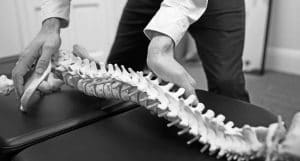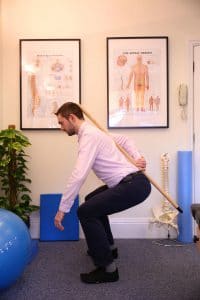Sciatica
How to treat sciatica in Derby
If you are from Derby or the surrounding areas and have sciatica, then this page is designed to give you a bit more detail and background to aid you – whether it is helping your understanding of what sciatica is, how it happened, or your best treatment and self-care options – we will cover it all here.
What is sciatica?

Sciatica means symptoms arising as a result of irritation to the sciatic nerve, which mostly gives people leg pain. Symptoms can vary (as you will see below) however most people will experience a combination of back pain, buttock pain, and leg pain (with or without pins and needles/numbness, or weakness).
The sciatic nerve is formed from multiple nerves leaving the lower spine at L4-S3. In the spine, between each vertebrae there are gaps called intervertebral foramen – which allow nerve roots to pass to and from the spinal cord. The nerve roots at segments L4-S3 join together to form the sciatic nerve – a little like multiple slip roads joining the M1. Once they are all joined the nerve courses down the buttock and back of the leg to the foot.
For sciatica to start, there needs to be enough pressure and force to irritate the nerve enough to give you symptoms. This pressure can be coming from many places, and mechanical examples include:
- disc herniations or bulges into the spinal canal
- impingement of the nerve root at the intervertebral foramen
- nerve root inflammation from facet joint sprains or local muscle strains
- sacro-iliac (pelvic) joint dysfunction
- referred pain from local trigger points within muscles,
- local muscle spasms and tightness such as piriformis syndrome
- and many more
As you can see there are actually many forms of sciatica – and if the advice is simply to rest or take pain medications to mask the pain then to be honest it doesn’t matter as much which type you have, as the advice would be the same. But for the best answers it would of course be beneficial to know which version of the above you have.
Once you know a specific cause and the underlying reason then you can manage it much more effectively, especially if you can figure out why it happened to begin with and find the root cause.
Why does sciatica happen in the first place?
Where your sciatica is coming from, and why it happened are two different things. If we are going to know how best to treat your sciatica, and the best advice we need to give you for self-managing and preventing it from coming back, then we need to know how and why it started in the first place. There is nothing worse than getting rid of the pain, only for it to repeat itself – that can be very frustrating for all involved!
It is quite common for patients to be in severe pain with sciatica and not know why it came about, so many times will patients say ‘it just came on’. And that is normal as 95% of problems we see in clinic have this same feature – the problem builds slowly going ‘under the radar’ until one more episode of tension or pressure tips it over the edge and it forms symptoms.

All of the above examples of exactly where sciatica comes from involve there being pressure on the sciatic nerve – a simplified version of this is to again think of the sciatic nerve like a motorway, if there is a blockage on one lane the traffic will move round easily. If it takes up more lanes then the traffic will build up, and the worse it is or the longer it stays there will dictate how far the back the traffic gets. The sciatic nerve is just the same. This pressure often comes on over a period of time due to repetitive or sustained tasks.
We have 4 in depth articles discussing the cause and effect relationship which can result in putting pressure on the discs and joints in the low back – which show how your whole body is connected. In our ‘Hidden causes of low back pain and sciatica’ series we explore some very common, yet largely ignored causes of low back pain and sciatica which are very intriguing and appear ‘hidden’ at first:
Part 1 discusses how neck issues can cause pressure in the low back
Part 2 gives an example of how ankle joint stiffness causes the issue
Part 3 highlights the importance of posture and rounding the shoulders
Part 4 discuss a specific foot problem called ‘over pronation’
How is sciatica diagnosed?
Approaching healthcare can be complicated so we have put together a guide for helping you chose the right team for your problem to help you see what you should be looking for.
Most of the time sciatica is due to mechanical problems in the spine, joints and muscles, which cause pressure on the sciatic nerve, resulting in pain, pins and needles, or weakness. However very rarely there can be other factors which can cause sciatic symptoms. Firstly we would want to know if there are any medical reasons which could be underlying and causing the sciatica which are not appropriate for manual treatment and need to be sent to the GP for medical attention. We call this ‘ruling out red flags’.
Chiropractors are registered with the GCC and have had a minimum of 4 years extensive training. Modules within the training course include pathology, medical history taking and examination, pathology, orthopaedic evaluation, and Chiropractic treatment techniques specifically for the spine and sciatica – as such Chiropractors are well placed to assess and treat patients with sciatica safely.
You can find out exactly what to expect in an initial consultation here, however for a physical assessment for someone with sciatica we would include:
- Postural analysis
- Neurological examination – to see which nerve root(s) are affected
- Orthopaedic testing – specific tests to identify mechanical conditions
- Joint and muscle assessment
- Functional testing – checking how your body is working for you
Chiropractors assess the whole body and truly understand the longer term changes and compensations which can result in dysfunction and injury. Or basically we understand cause and effect. Causes of sciatica can be from poor bending technique or something as silly as sitting on your wallet in the back pocket! If we can treat a patient to resolve the symptoms of sciatica, and also have figured out the exact cause in the first place, then it greatly minimises the risk of it coming back again and everyone is happy.
The best approach for treating sciatica

Hopefully we have already set the scene for this with everything discussed above – for us at Duffield Chiropractic Clinic we believe the most important thing is to find out the root cause of any injury causing someone’s pain. It allows targeted advice, which then allows us to be more effective in helping people with their sciatic pain. Once we know this we can create the best plan for getting patients better quickly – and this will be different for everyone.
Sciatica is not just leg pain – go back to the top of the page and have a look at just some of the specific causes of scaitica – there are so many! And as such they should all have different treatment plans. For example the advice and treatment we give patients at the clinic who have sciatica as a result of a bulging disc will differ from those who have sciatica due to tight muscles or piriformis syndrome.
The best approach is something that is specific to your problem – book an appointment to see us here
How to prevent sciatica
You ideally need to know exactly where your sciatica is coming from in the first place, however if you have had sciatica in the past, or had treatment from us and now need to know how to prevent it, here are the best tips:

- Stop bending for damaged discs – the main advice we emphasise to patients with disc problems causing sciatica is to minimise bending as much as possible. This doesn’t just mean bending to lift things which are heavy, this means not bending when you are getting out of bed, brushing your teeth, washing your face, putting on your shoes or socks, preparing food in the kitchen and so on. Every time you bend improperly you will put pressure on the discs and if they are bulging onto the sciatic nerve this will not help. Once you have had treatment it is easier to move your body and your Chiropractor will show you how to lean and reach correctly minimising the cause of sciatica. Until then just try your best not to bend over as often!
- Relax muscles causing sciatica – if your problem is for example due to muscular tightness causing pressure onto the sciatic nerve then we will want to relieve that pressure by relaxing those muscles. Heat will relax muscles so you may find it useful to put a hot water bottle on the area of pain down the leg, or have a warm bath. You can also relieve tight muscles by stretching the glutes (lie on your back and hug the knee towards the opposite shoulder until you get a comfortable stretch into the muscle). At the clinic we go a little bit deeper in our assessment and find out why those muscles are tight in the first place, and target our treatment at the cause, not the effect.
- Move more, sit less. This is the advice which is appropriate whether you have a disc problem or a muscular problem causing your sciatica. The more you sit it will put pressure on the joints, muscles, discs and nerves, which will add more pressure onto the sciatic nerve giving you those unpleasant symptoms of sciatica. Conversely getting up and pottering around will gently loosen up those stiffer areas and can help your recovery.
For generally improving your posture here are our top 5 tips however if you need a specialist assessment and treatment call or book online for an appointment.
